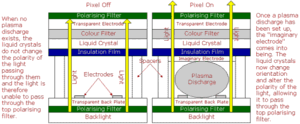A hybrid of the LCD and a PDP: the Plasma Addressed Liquid Crystal (PALC) display.
The main drawback to the use of the TFT is that, as with any semiconductor process, manufacturing of large sized chips on displays is extremely difficult. If a substitute for the TFT could be found that can be made in large sizes, production costs could be brought down.
The plasma display doesn’t seem a likely candidate as a TFT replacement. In a standard PDP, the plasma generates UV light which then excites phosphors, causing them to emit visible light. However, a plasma can also operate as a switch in much the same way as the TFT does in an AM LCD.
Like the PDP, the PALC pixel cell has three electrodes. The lower two initiate the plasma discharge which then begins conducting electrons and becomes, in effect, an “imaginary electrode”. Current then flows between this imaginary electrode and the third, transparent electrode. Between the two lies the liquid crystal which responds to the voltage in the same way as it would in a TFT AM LCD, changing orientation, altering the polarisation of light from the backlight and enabling it to pass through the top polarising filter.
The PALC was invented by the US firm Tektronix, which licensed the technology to Sony in 1993 and helped in the development of Sony’s Plasmatron display. In October 1996, Sony entered a three year agreement with Sharp to further develop the PALC display and the two were joined in July 1997 by Philips. Sharp’s contribution was to be an increase in viewing angle while Philips was to develop higher-resolution displays, improve cell aperture, reduce power consumption and increase brightness. In 1998, the companies started to re-position PALC as a technology that is suitable for high ambient light applications because to maintain performance it is relatively simple to boost backlight output whereas PDPs have limited brightness and have difficulty producing a strong performance in high ambient light environments.
All three have funded further development by Technical Visions, a company formed by PALC pioneer Thomas Buzak. Although great improvements have been made, the production costs are still high. Sony has said that it expects the new displays to be ready for commercialisation in the year 2000 but it will be interesting to see if the Sony/Sharp agreement, due to run out at the end of September 1999, will be renewed.
Update: At the time of writing there has been no activity on PALC for several years as far as we are aware.

